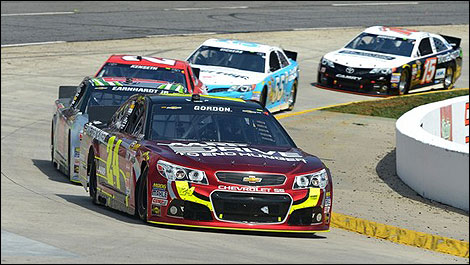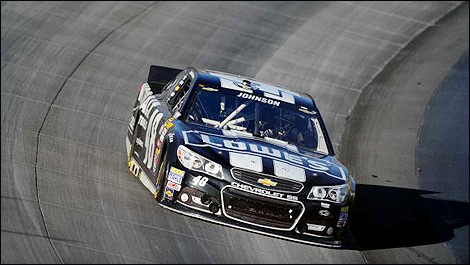Jan
23rd
Stay connected Subscribe to our RSS feed
NASCAR officials got it right when then decided to go for knock-out qualifying at most races in its' top three series.
As much as this writer feels skeptical about the unannounced changes to the Chase rules, the knockout rules adopted by NASCAR bring it along the lines of Formula One, IndyCar and a number of other series. IndyCar is slightly different as it divides the field into two sessions for round one.
What it means is that you'll see an exciting intense of two or three sessions with implications for the “big” race.
For example qualifying will be completed in about one-hour. With all of the cars on the track for the first 25 minutes session (at all Sprint Cup races but the Daytona 500). What better way for fans to see who's good that weekend, vis-à-vis other drivers, and television will love it as the show wraps up in around one hour.
Texas Motor Speedway president, Eddie Gossage, said in a statement “I think fans are going to love this because it basically means another race day to race weekend. Qualifying day is going to be a race in and of itself with speed, a lot of competition and a lot of strategy.”
The other wrinkle is that with 42-drivers on the track in the first knock-out session there will be unintended, as well intended, opportunities for the drivers to assist a rival in being knocked out. We'll have to wait and see what NASCAR does to some driver they view as intentionally causing a wreck.
For years this reporter, and many others, likely had trouble getting excited to watch one car on a big track go out for one slow and two fast laps. I'd bet I could hear and see grass growing during Brickyard 400 qualifying.
The only thing this writer doesn't like and still cares about is that there ought to be a one point bonus for winning the pole. Especially in this instance when a driver has to perform in race-like conditions.
Thinking back to Formula One qualifying, even before the knock out system, I recall how thrilling it was to see the late Ayrton Senna carving through the field like a surgeon doing brain surgery. And, of course , the Brazilian was doing it at high speed.
Obviously oval qualifying is nothing like road course qualifying, but, still - we can hope for moments of shear driving brilliance as Gossage said qualifying is going to be a “a race in and of itself.”
Now if only NASCAR would consider it worth more than a picture, a check , and a pit stall selection it would be close to perfect.
The Rules:
At tracks measuring 1.25 miles in length or larger, qualifying for the Coors Light Pole Award will consist of three rounds:
• The first qualifying elimination round will be 25 minutes in duration and includes all cars / trucks. The 24 cars / trucks that post the fastest single lap from the first qualifying round will advance to the second round.
• The remaining cars / trucks will be sorted based on their times posted in the first round of qualifying in descending order.
• The second qualifying elimination round will be 10 minutes in duration and the 12 cars / trucks that post the fastest single lap time will advance to the third and final round. The fastest remaining cars / trucks earn positions 13th through 24th based on their times posted in qualifying in descending order.
• The third and final qualifying round will be five minutes in duration and the fastest single lap time will determine positions 1st through 12th in descending order.
• There will be a five-minute break between each qualifying round.
At tracks measuring less than 1.25 miles, qualifying for the Coors Light Pole Award will consist of two rounds:
• The first qualifying elimination round will be 30 minutes in duration and includes all cars / trucks. The 12 cars / trucks that post the fastest single lap time from the first qualifying round will advance to the second and final round.
• The remaining cars / trucks will be sorted based on their times posted in the first round of qualifying in descending order.
• There will be a 10-minute break between the two qualifying rounds.
• The second and final qualifying round will be 10 minutes in duration and the fastest single lap time posted will determine positions 1st through 12th in descending order.
The new qualifying format does not apply to the Daytona 500, which will preserve its historic and unique qualifying format. Additionally, it does not apply to non-points NASCAR Sprint Cup Series events or the NASCAR Camping World Truck Series event at Eldora Speedway.
As much as this writer feels skeptical about the unannounced changes to the Chase rules, the knockout rules adopted by NASCAR bring it along the lines of Formula One, IndyCar and a number of other series. IndyCar is slightly different as it divides the field into two sessions for round one.
What it means is that you'll see an exciting intense of two or three sessions with implications for the “big” race.
For example qualifying will be completed in about one-hour. With all of the cars on the track for the first 25 minutes session (at all Sprint Cup races but the Daytona 500). What better way for fans to see who's good that weekend, vis-à-vis other drivers, and television will love it as the show wraps up in around one hour.
 |
| Photo: NASCAR |
Texas Motor Speedway president, Eddie Gossage, said in a statement “I think fans are going to love this because it basically means another race day to race weekend. Qualifying day is going to be a race in and of itself with speed, a lot of competition and a lot of strategy.”
The other wrinkle is that with 42-drivers on the track in the first knock-out session there will be unintended, as well intended, opportunities for the drivers to assist a rival in being knocked out. We'll have to wait and see what NASCAR does to some driver they view as intentionally causing a wreck.
For years this reporter, and many others, likely had trouble getting excited to watch one car on a big track go out for one slow and two fast laps. I'd bet I could hear and see grass growing during Brickyard 400 qualifying.
The only thing this writer doesn't like and still cares about is that there ought to be a one point bonus for winning the pole. Especially in this instance when a driver has to perform in race-like conditions.
Thinking back to Formula One qualifying, even before the knock out system, I recall how thrilling it was to see the late Ayrton Senna carving through the field like a surgeon doing brain surgery. And, of course , the Brazilian was doing it at high speed.
Obviously oval qualifying is nothing like road course qualifying, but, still - we can hope for moments of shear driving brilliance as Gossage said qualifying is going to be a “a race in and of itself.”
Now if only NASCAR would consider it worth more than a picture, a check , and a pit stall selection it would be close to perfect.
 |
| Jimmie Johnson, Chevrolet SS, 2013 Sprint Cup Champion. (Photo: NASCAR) |
The Rules:
At tracks measuring 1.25 miles in length or larger, qualifying for the Coors Light Pole Award will consist of three rounds:
• The first qualifying elimination round will be 25 minutes in duration and includes all cars / trucks. The 24 cars / trucks that post the fastest single lap from the first qualifying round will advance to the second round.
• The remaining cars / trucks will be sorted based on their times posted in the first round of qualifying in descending order.
• The second qualifying elimination round will be 10 minutes in duration and the 12 cars / trucks that post the fastest single lap time will advance to the third and final round. The fastest remaining cars / trucks earn positions 13th through 24th based on their times posted in qualifying in descending order.
• The third and final qualifying round will be five minutes in duration and the fastest single lap time will determine positions 1st through 12th in descending order.
• There will be a five-minute break between each qualifying round.
At tracks measuring less than 1.25 miles, qualifying for the Coors Light Pole Award will consist of two rounds:
• The first qualifying elimination round will be 30 minutes in duration and includes all cars / trucks. The 12 cars / trucks that post the fastest single lap time from the first qualifying round will advance to the second and final round.
• The remaining cars / trucks will be sorted based on their times posted in the first round of qualifying in descending order.
• There will be a 10-minute break between the two qualifying rounds.
• The second and final qualifying round will be 10 minutes in duration and the fastest single lap time posted will determine positions 1st through 12th in descending order.
The new qualifying format does not apply to the Daytona 500, which will preserve its historic and unique qualifying format. Additionally, it does not apply to non-points NASCAR Sprint Cup Series events or the NASCAR Camping World Truck Series event at Eldora Speedway.
 The latest auto news, reviews, prices, product and vehicle releases.
The latest auto news, reviews, prices, product and vehicle releases.